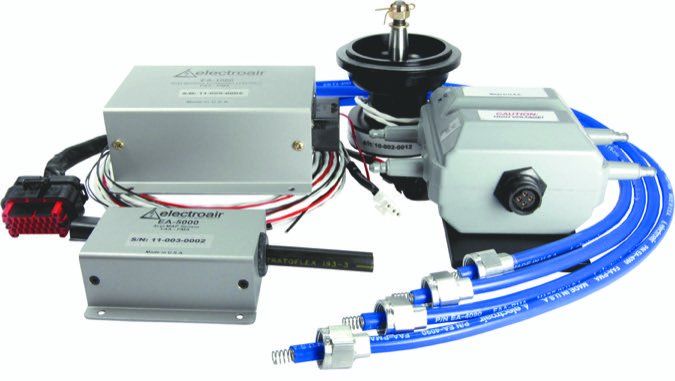Magnetos have been around so long that one can’t help but wonder if Benjamin Franklin went directly from his supposed kite-into-a-thunderstorm electricity experiment to his basement where he built the first one.
While reliable, continuing to use mags on piston aircraft engines isn’t terribly efficient. They always fire the spark plugs at the same point—usually 25 degrees before top dead center (TDC)—and rely on the combustion event ignited to carry on by itself to reach maximum pressure by the time the piston reaches 11 to 17 degrees past TDC. Mags put out a spark that is on the order of 12,000 volts. That’s good, but not great. Finally, magnetos wear out faster than many other components in the airplane and need to be pulled for inspection and repair or replacement every 500 hours, not a trivial expense.
Automotive technology long ago gave us electronic ignitions that advance or retard the spark (adjust the position relative to TDC at which the plugs are fired) to greatly increase the power and efficiency of the combustion event and lengthen the time the plug fires—creating a hotter, longer-lasting ignition source that increases power output as we’ll as making starting easier and reducing plug fouling. Finally, electronic ignition provides some five times the voltage to the plugs—70,000 volts—creating the hotter spark.
Variable Timing
We’ve had variable engine timing in aviation since spark advance was first used prior to World War I—it’s a major reason why some WWI airplanes could get to 20,000 feet. The advent of the microprocessor meant that engine timing could be precisely controlled and set for maximum power and efficiency in the conditions in which the engine was flying. It is especially valuable at higher altitudes and in turbocharged airplanes.
What we consider to be the leader in the field of electronic ignition for piston-engine airplanes is Electroair (www.electroair.net), based in Howell, Michigan. It originally developed its electronic ignition system (EIS) for homebuilt aircraft.
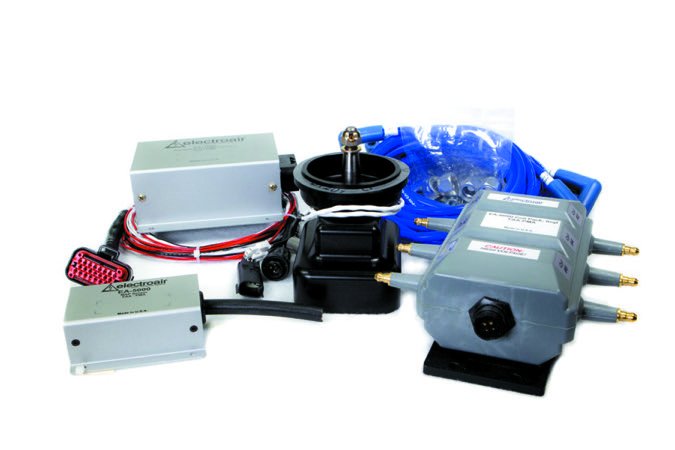
In 2011 Electroair received its first STC for installation of its EIS on certificated airplanes with four-cylinder Lycoming engines. Electroair now has STCs for over 400 different aircraft models—singles and twins—and the number is increasing.
Electroair’s System
Electroair’s EIS is a high-energy, tuned electronic ignition system developed from a high-performance automotive system designed for racing. Installed, it replaces one of the aircraft’s magnetos. Not only does the system alter the timing of the onset of plug firing and provide a much higher-power spark, it provides a longer spark event that results in burning the fuel more completely.
The system has four main components: a manifold pressure sensor, direct-fire coil pack, electronic control unit and a mag timing housing. There is also a set of high-tension cable leads with terminals installed provided with the kit.
Timing is picked up by a “60 minus 2 tooth” trigger wheel with a single magnetic pickup; it provides a high-resolution signal feeding continuous RPM information to the control unit—similar to automotive units in the 1980s.
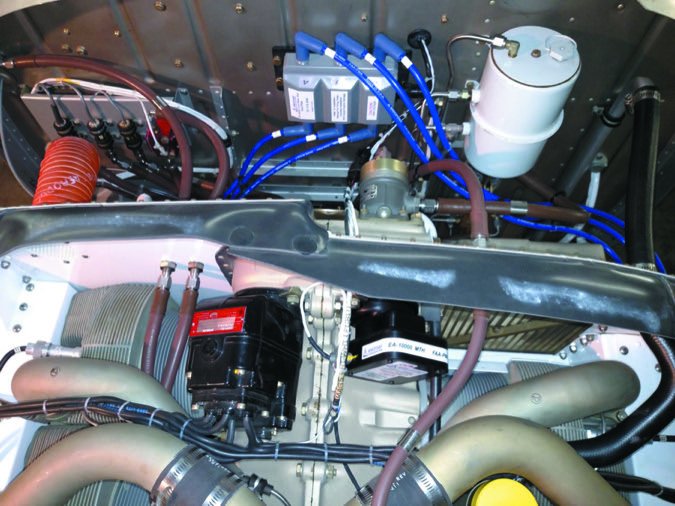
The dual microprocessor electronic control unit receives RPM and manifold pressure information and advances the timing to compensate for altitude and throttle position based on proprietary and patented algorithms. Timing can be advanced as much as 20 degrees.
The direct-fire coils are the reason the system can produce 70,000 volts to the plugs. In addition, the spark produced lasts through 20 degrees of crank rotation versus five for a mag. This creates a hotter, longer-lasting ignition source. It also improves starting and reduces spark plug fouling—something owners we spoke with confirmed. Because of reduced plug fouling with the EIS, Electroair recommends installing it on the bottom plugs as they are more prone to fouling.
We were curious as to why both mags were not replaced. Company co-owner Mike Kobylik explained that replacing just one mag gives 85 percent of the performance increase that would occur with the EIS in place of both mags. Certification requirements for an EIS that replaced both mags would require dual, independent electrical power sources, causing the cost to skyrocket.
Remaining Mag
Because the remaining mag still fires at 25 degrees before TDC when the EIS has advanced the timing, the spark it creates occurs when the combustion event is underway, so its spark is wasted. It’s why the system is sometimes referred to as a “wasted spark system.” Having a 12,000-volt spark in the midst of a 70,000-volt spark-created combustion event doesn’t do much to help the event and doesn’t hurt it.
However, because the mag is still there, doing its job, should the EIS fail, the mag performs its backup role as a normal magneto to keep the engine running.
We do note in passing that should engine roughness develop in flight, whether it is on a dual-magneto system or single mag and EIS, that an important step in troubleshooting the problem is to do a mag check. If one mag, or the EIS, is causing the engine roughness, shut it off. Continuing to allow a malfunctioning magneto (or EIS) to run risks the mistimed spark causing pre-ignition and/or detonation, which can cause catastrophic damage to the engine.

We bring this up because during our recent visit to Electroair we were told that they’d been contacted by an FAA inspector working on a matter in which a student pilot flying an EIS-equipped airplane experienced engine roughness. The student found that the single mag installed was causing the roughness and shut it off, continuing the flight with the EIS to a safe landing.
Amazingly, to us, the FAA inspector felt that the student should have left the bad mag on. Electroair personnel were able to provide the inspector with data on the seriousness of the risk of continuing to run a bad mag. Their follow up revealed that some pilots are not aware of the need to shut off a mag that is malfunctioning.
What’s It Going To Cost?
List price of the four-cylinder system is $3570—price for the six-cylinder system is $4950.
Installation time varies, according to Kobylik and owners we spoke with. The system is going into a legacy airplane that may have had a number of modifications, so installation will require some planning. Les Ojala, director of maintenance at AVflight in Lansing, Michigan, told us that going over the installation instructions carefully, before doing anything, pays off because much of the installation involves determining where to put components. He also recommended calling Electroair as soon as a question comes up.
The installation instructions are on the website—a practice we wish more manufacturers would follow—so a potential buyer and her or his shop can look them over in detail before making a purchase. Kobylik told us that often technicians spot potential installation challenges because of their knowledge and experience with the particular airplane—and they’ll then call Electroair to get answers. Electroair’s customer support personnel are all A&P mechanics and pilots; each has some 40 years of experience swinging wrenches.
Kobylik recommends allowing two days for a four-cylinder engine—one day for the install and one day to take care of the little things that always seem to come up. For a six-cylinder engine, he recommends three days—two for the install and one for everything else.
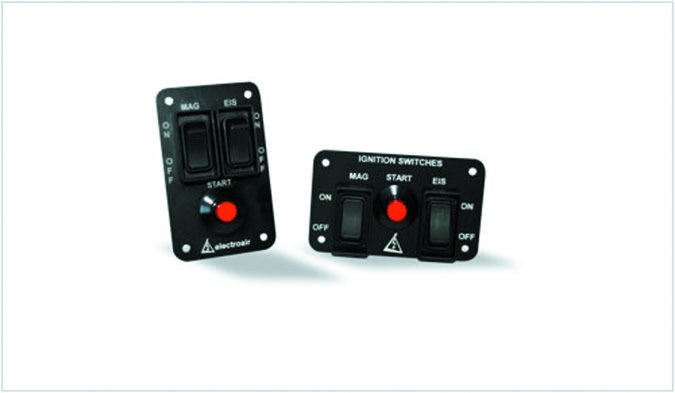
Electroair has set up a network of approved installation centers and has been collecting installation data from technicians in the field—problems they’ve had, best places to install components on various types of airplanes as we’ll as effective troubleshooting techniques—and shares the information with the centers. At least one maintenance technician from each approved center has been to Electroair for training.
Kobylik said that where the company sees problems in the field, they almost invariably arise from incorrect installation—the instructions have to be followed precisely.
Performance
The selling point of electronic ignition, beyond reliability and longevity, is performance. Optimizing the combustion event via advancing the timing and providing a longer, hotter spark means that each event will burn the fuel more completely, resulting in greater power output. It’s a no-brainer that was learned in the automotive world years ago.
The question for aeronautical use is how does the additional power output translate into performance in the air. Electroair forecasts fuel savings of one to two GPH and some degree of cruise speed increase—and points out that the benefits of spark advance increase with altitude.
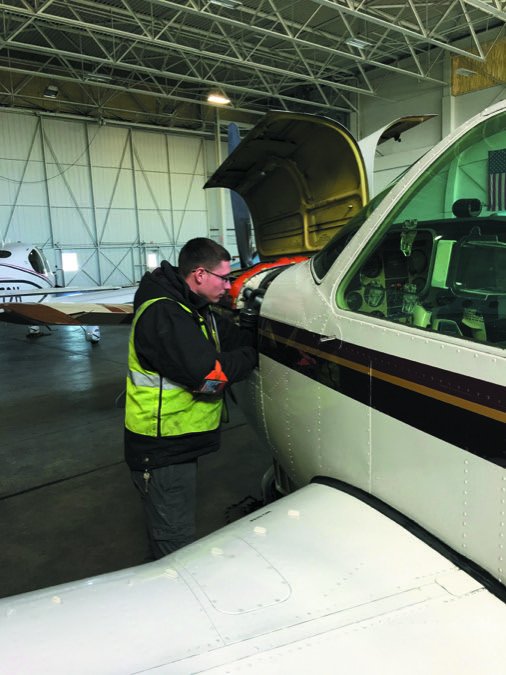
Kobylik collects performance data provided by customers and shares it on the company website. A turbonormalized Comanche owner stated that using the same power settings he used prior to installing the EIS, he is burning two GPH less for the same true airspeed. The same results were noted by the owner of a Piper Saratoga—fuel burn reduced by two GPH for the same true airspeed. Users advised that the fuel savings was the same when operating rich or lean of peak. Some noted increased smoothness when operating lean of peak.
A flying club operating Cessna 172s reported a reduction in average fuel consumption of 1.25 GPH according to the records it kept on fuel consumption on club airplanes.
Ignition Switch
Electroair also offers a $269 replacement for the rotary key ignition switch and starter found in most aircraft. The benefit is getting rid of a switch that is subject to ADs and replacing it with rocker switches that identify which activates the magneto and EIS as we’ll as using a push-button start. Kobylik touted the replacement switch as safer because the pilot is less likely to do a hurried RPM drop check during runup.
Installation requires finding panel space. We don’t have a strong opinion on the replacement switch although we do like flying airplanes that have toggle switches for the mags, such as Cessna twins and the American Champion line. Plus we don’t have to worry about strapping in and then realizing that the ignition key is still in a pocket.
We are watching two new products Electroair is developing: a combination magneto/EIS replacement for the long-maligned Bendix dual mag and a spark plug with an automotive-type end.
Electrolair EIS In Service: Two Owners’ Perspectives
While at Electroair, we asked to be put in touch with owners who had installed its EIS and would be willing to speak with us about their experience of using it for the type of flying they do. I’m not sure we could have gotten examples from further apart on the personal flying continuum had we tried.
We first met Jim Huber at Avflight on the Lansing, Michigan, airport where he keeps his A36 Bonanza. That’s it in the upper photo with maintenance technician Jordan English taking a look at the Electroair EIS Huber had installed just over a year ago.
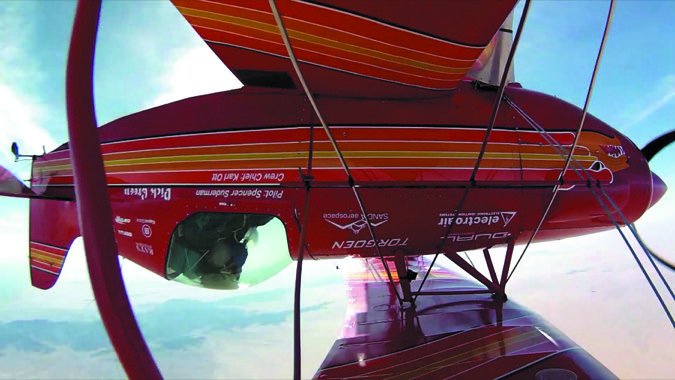
Huber, a former Air Force pilot, said that he generally tries to do some sort of upgrade to his airplane each year and the Electroair EIS rose to the top of the pile of prospects due to the type of flying he does. Because his grandchildren live in Dallas, he and his wife regularly use their Bonanza to fly there for visits. The problem that he had was that it is a five-hour flight and even with tip tanks, he could not make the trip nonstop and have adequate fuel reserves to meet his personal minimums—for him that means IFR fuel reserves plus an extra margin for comfort.
In the search for a solution Huber considered larger tip tanks, but then started reading about the performance improvements possible with Electroair’s electronic ignition. He said that “even if the system only delivered half of what was claimed” he’d have what he needed.
Huber told us that installation took some time as it was the first one his shop had done. He said that the techs kept a computer with the installation instructions displayed parked on a rolling table right by the airplane so they could refer to the instructions easily—something that was helpful. The techs made “three or four” calls to Electroair and got fast, accurate answers to their questions. There were no problems following the installation.
Because of his military background, Huber logs his flights in some detail. On his flights to Dallas—and other multiple-hour trips—since installation, Huber told us that he followed his usual practice of flying at 9000 or 10,000 feet at the power setting he ordinarily used. His fuel burn has dropped by 1.5 to 2 GPH and true airspeed has averaged five knots faster. The combination, over a five-hour flight, now gives him fuel reserves that make it comfortable for him to make the Lansing-Dallas run nonstop.
Huber said that the performance benefits are less noticeable when flying lower, although the rate of climb has increased at all altitudes.
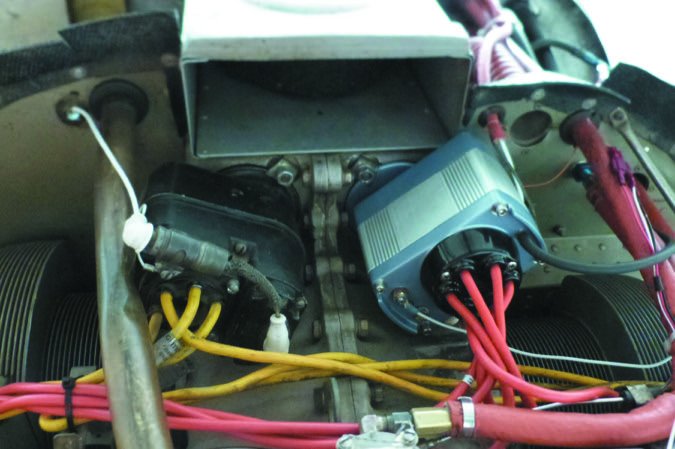
Airshow pilot Spencer Suderman had a fairly straightforward goal: He wanted to break the record for the number of turns in an inverted flat spin. That meant climbing as high as possible to enter the spin. On the way down the engine had to put out as much power as possible to minimize the altitude loss per rotation.
His initial attempt, in a Pitts S2B, was unsuccessful even though he’d been able to climb higher to enter the spin than the record-holder. In discussing the matter of power, Suderman received suggestions to advance the timing of the engine on the ground so it would make more power at altitude but to be careful not to detonate the engine during the first portion of the climb. It didn’t sound like a great idea.
Suderman then learned of Mike Kobylik and the work being done at Electroair with electronic ignition and advancing engine timing automatically. At the same time, Electroair wanted to get an STC for its EIS on a six-cylinder Continental engine, so it was agreed to install a conforming prototype of the EIS on Suderman’s Pitts so he could have a go at the record and get sophisticated operational data on the EIS for certification, although not simultaneously.
The additional power allowed Suderman to climb 10 percent higher—previously the Pitts topped out at 21,000 feet. Now he was able to get above 23,000 feet.
On the record attempt on March 13, 2014, Suderman entered an inverted spin at just above 23,000 feet and made 81 turns before recovering at 2000 feet AGL.
Suderman next moved to a modified Pitts S-1—a Sunbird S-1X—for its more rapid rate of rotation. Working with Electroair, he installed the EIS on the airplane’s O-540 engine. On March 20, 2016, Suderman climbed to 24,500 feet and started spinning. He completed 98 turns before recovering at 2,000 feet AGL (lower photo).
Suderman told us that the extra power provided by the Electroair EIS was one of the reasons he could break the spin records while noting that with only about 1.5 hours of endurance in the S-1X, he’s not able to take much advantage of the reduced fuel consumption available with electronic ignition. However, he did point out that when going to high altitude he didn’t have to deal with heavy, pressurized magnetos, another EIS benefit.
Surefly’s Sim Drop-In Ignition
Texas-based SureFly was created by the folks who launched Sky-Tek (starters) and Plane-Power (alternators). After selling the companies, the focus has been to earn an STC for the SureFly Ignition Module, called SIM for short.
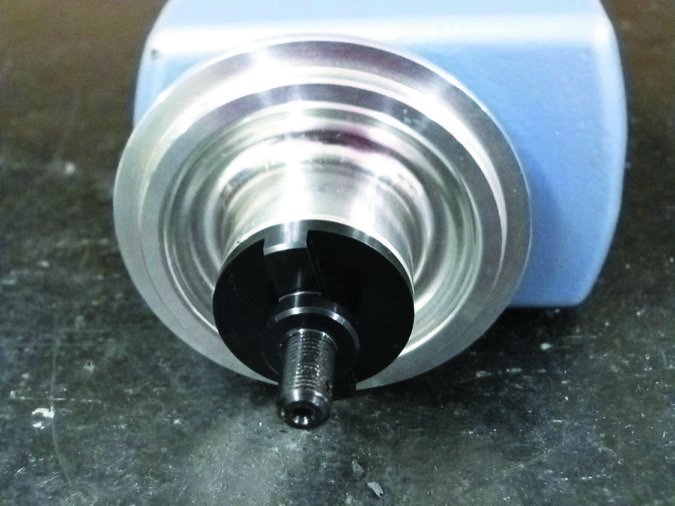
The SIM concept is simple and was created in less than 30 days, but FAA certification has been dragging on far longer than expected—a couple of years so far. The goal was to make the SIM installation as easy as possible. Like Electroair’s ignition, the SIM electronic ignition module replaces only one of the magnetos and is completely solid state. It also uses standard ignition wiring harnesses, but there’s no impulse coupling because the system controls the ignition timing by manifold pressure and RPM.
Rather than using spinning magnets and a bunch of anachronistic parts, the SIM electronically converts battery power into a high-voltage signal and pulses it to the right cylinder at just the right time. That’s a SIM module sitting to the left of a Slick magneto in the main image in the center of the page, and the drive side of the module in the photo at the lower left of the page.
One SIM unit is basically the same size and weight as a Slick mag and a couple of pounds lighter than a Bendix. There are no moving parts, it’s fully electronic, it requires no software updates and it mounts to the engine the same way a traditional magneto does.
The SIM can be adjusted to any engine’s base timing advance (specified on the engine data plate) by a switching module that is accessible through a large port on the case. Through electronics, there is more spark energy throughout the RPM range and the dwell is adjusted automatically. Each spark plug has its own dedicated coil, virtually eliminating coil failures.
SureFly said an experienced technician should have the installation completed in roughly an hour or so, but that might not include access and disassembly, and of course paperwork and testing at the end. One of the reasons for an easy installation is there aren’t remote boxes and additional components to put on. The SIM retains the existing spark plugs and the magneto switch on the instrument panel.
For installation, a power wire, ignition switch P-lead and manifold pressure connection are required, and the engine’s RPM signal is picked up within the SIM module from the crank gear. SureFly says the SIM is designed to last throughout the TBO of the engine for which it’s installed,: there should be no downtime for regular inspections, no messing with the timing or risking the possibility of failures due to these inspections/adjustments. But unlike the Electroair’s variable timing system, the SureFly SIM isn’t exactly intended for serious performance gains. Instead, think of the SIM as a simplified, maintenance-free ignition system without points, condenser, rotor and cap.
But SureFly does make claims of increased spark energy throughout the engine’s RPM range and that has everything to do with solid-state ignition timing. A long spark dwell promises consistently easier starts, especially on engines with oil-soaked spark plugs. Below 400 RPM, the timing is set to TDC (top dead center, or the position farthest from the crankshaft), with a longer dwell and increased voltage. There’s also the potential for better fuel efficiency in cruise flight thanks to more consistent fuel burn in the cylinders.
There are several models of the SIM depending on the engine and magnetos. The 3.6-pound SIM4P module is for impulse-coupled magneto replacement and the majority of four-cylinder applications will use this one. It uses the existing impulse-coupled drive gear, the drive adapter and the mounting studs. The 3.4-pound SIM4N is for non-impulse-coupled magnetos on both Lycoming and Continental engines, where it plugs directly into the rear of the engine. There’s also the 5-pound SIM6L and SIM6C for replacing the mags on other Lycoming and Continental engines.
SureFly’s general manager, Jason Hutchinson, told us the company is hoping to secure FAA certification for the SIM this coming summer, which will be via an AML-STC, encompassing both the engine and the airframe in which it’s installed. Pricing for four-cylinder applications will start at $1250 and six-cylinder applications will start at $1550. Contact www.surefly.net and at 817-373-5161 in Granbury, Texas.
Conclusion
What we’ve seen in terms of performance increase available via a high-energy, variable timing ignition system over conventional magnetos causes us to wonder why they are not on all OEM aircraft. For someone who routinely makes flights of at least two hours at moderate or high altitudes, we think Electroair’s EIS is a no-brainer. Not only should the money saved in reduced fuel consumption and not having to repair or replace one of the mags every 500 hours pay for the system in a few years, the increased overall reliability of the ignition system and improved rate of climb may be thought of as increasing the level of safety of the airplane. Any cruise speed increase is gravy.

